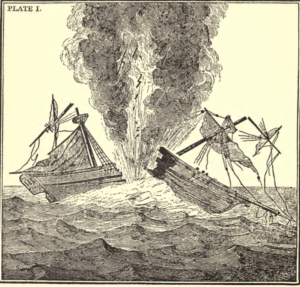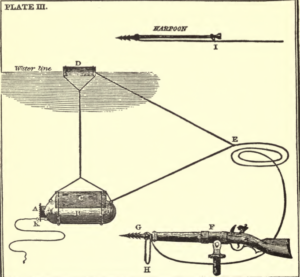
Another in the series of posts about historical use of IEDs. I’ve been slowly gathering material on naval use of IEDs , and have some great stories to tell. In future weeks I’ll write about:
- Three massive ship borne IEDs of 1673, 1693 and 1694, (used by the British Navy against the French)
- Floating IEDs designed by Cornelius Drebbel in the 1620s, (used by the British Navy against the French)
- An attack using an IED on a ship in the Tagus in 1650 (by the British parliamentarian Navy on a British royalist ship)
- An attack off Boulogne on 1804 using a fascinatingly designed IED on a small catamaran, (used by the British Navy against the French)
- Admiral Benbow’s attacks and Admiral Cochrane’s attacks (on the French in St Malo) using massive IEDs in 1693 and 1809 and their spooky similarity with the Campbeltown attack in the raid on St Nazaire in WW2
For now, I’m again I’m grateful to Leslie Payne for flagging me a source document – a letter from Robert Fulton to the President of the USA in 1810.
Fulton was an interesting man who worked on a range of naval engineering matters. Born in the USA in 1765, he experimented with explosives as a child and developed paddle wheels for his father’s fishing boat . By 1797 he was a well-known inventor in Europe and was building steam boats and a submarine, the Nautilus, for Napoleon Bonaparte. Some sources suggest he was also making explosive charges for the French Navy
France and England were at war at the time (as usual). In 1804 Fulton switched sides and went to England to offer his inventions there. He was commissioned by the Prime Minister, William Pitt, to develop a range of Naval weapons including explosive charges. It is in this period that the attack, described below, occurs.
Fulton then switched allegiances again and went home to the US, to build submarines and torpedoes for use against the British. In 1810 he wrote a letter to the President James Madison on the subject of “The Torpedo War and submarine explosions”. The letter is interesting on several levels:
- It describes a very successful demonstration undertaken by Fulton, where he blew up a ship as a demonstration to the Prime Minister off the cost near deal in Kent in 1805. (Samuel Colt conducted a similar experiment a few decades later for the US Navy in the Potomac near the Navy yards.)
- Initially the devices were large (180 pounds of gunpowder) and initiated by clockwork with an 18 minute delay.
- There is a beautiful quote about a sceptical British Naval observer to the trial; “Twenty minutes before the Dorothea was blown up, Capt Kingston asserted that if a Torpedo were placed under his cabin while he was at dinner, he should feel no concern for the consequence. Occular demonstration is the best proof for all men.”
- A pithy quote from a British Admiral, Earl St Vincent, who said of the Prime Minister’s enthusiasm for Fultons plans “ Pitt was the greatest fool that ever existed, to encourage a mode of war which they who commanded the seas did not want, and which, if successful, would deprive them of it”
- It describes a similar experiment conducted in New York harbour in 1807, but which failed at first because of a design fault in the explosive devices.
- A detailed description and diagram of the device. Although the demonstrations used clockwork initiation systems, Fulton designed a lever switch which a passing ship would act on, so causing a cocked gun trigger to fire, initiating the charge.
- An “attack torpedo” using a clockwork timer and a harpoon gun to fasten the torpedo to a target.

- A detailed description of the attack on the French ships anchored off Boulogne by Capt Siccombe of the Royal Navy and his men in 1805. In two separate attacks, one led by Capt Siccombe and another by Lt Payne, the “infernal machines” failed to seriously damage the ships, and Fulton conducted a rapid technical evaluation to attempt to understand why. It appears that the ballast adjustments of the two charges were incorrectly set, so the charges detonated on the surface of the water next to the ships rather than under the keel as intended.
- The letter describes the efficacy that a few well armed, fast moving small boats can have on a major naval fleet, if moving at speed and with novel weapons…. (Iran, Persian gulf, Sixth fleet….any premonitions?) and discusses the cost effectiveness of his infernal machines against warships and the asymmetric warfare principles behind it. He describes how a fleet of small boats could command an area like the Straits of Dover (or the Persian Gulf!)
Update on Friday, September 28, 2012 at 9:17PM by Roger Davies
This is beautiful!. Here’s a document I just found – a legal contract between the British Government and Fulton, Note the values of his rewards and also his promise not to divulge the plans to anyone else for 14 years (a promise he broke in his letter to President Madison)
Articles of Agreement between the Right Honourable William Pitt, first
Lord Commissioner of his Majesty’s treasury and Chancelor of the Exchequer,
and the Right Honourable Lord Viscount Melville, first Lord of the
Admiralty, in behalf of his Majesty’s government on the one part, and Robert
Fulton, citizen of the United States of America and inventor of a plan of
attacking fleets by submarine Bombs, on the other part.
The said Robert Fulton agrees to disclose the principles of his scheme
to Sir Home Popham and to superintend the execution of it on the following
conditions:
First. To be paid Two hundred pounds a month while he is employed on
this Service for his personal trouble and Expences.
Second. To have a credit lodged from time to time for the payment of his
Mechanical preparation, not to exceed Seven thousand pounds.
Third. That in his Majesty’s dockyards and Arsenals shall be made or
furnished all such articles as may be required which are applicable to this
purpose.
Fourth. If any circumstance should arise to prevent government carrying
this plan into execution then the parties are each to name two commissioners
for the purpose of examining the principles; and trying such experiments as
they may think proper, and if it should appear to the Majority of the
members that the plan is practicable and offers a more effectual mode of
destroying the enemies fleet at Boulogne, Brest, or elsewhere, than any now
in practise and with less risk, then government is to pay the said Robert
Fulton the sum of Forty Thousand Pounds as a compensation for demonstrating
the principles, and making over the entire possession of his submarine mode
of attack.
Fifth. When the said Robert Fulton has destroyed by his submarine
carcasses or Bombs one of the enemies decked Vessels, then Government is to
pay him the sum of Forty Thousand pounds, provided Commissioners appointed
As in the previous article shall be of opinion that the same Scheme can be
practically applied to the destruction of the enemies fleets.
Sixth. If the Arbitrators differ in opinion then they are to draw lots
for the choice of an Umpire and the majority of the Voices to decide all
points of reference within the construction of this agreement and that
decision to be final.
Seventh. One half the supposed value of all vessels destroyed by Mr.
Fulton’s Submarine mode of attack to be paid him by government as long as he
superintends the execution of his plan; but when government has no further
occasion for his services; or that he wishes to retire then he is only to be
paid one quarter of the supposed value of such vessels as may be destroyed
by his scheme, and this remuneration to continue for the space of fourteen
years from the date hereof.
Eighth. In case the Vessels destroyed by this scheme should exceed in
amount Forty thousand pounds, then the Forty Thousand pounds first
stipulated to be paid, shall be considered as part payment of the whole sum
which may become due to the said Robert Fulton.
Ninth. If in the course of practice any improvements Should be Suggested
that can only be esteemed as a collateral Aid to the general principles of
Mr. Fulton’s mode of attack, then such improvements are not to demenesh or
set aside his claims on government.
Tenth. All monies which may become due to Mr. Fulton to be paid within
six months from the time when they shall be so adjudged according to the
tenor of this agreement.
Eleventh. This agreement to be considered by both parties as a liberal
covenant with a View to protect the Rights of the individual, and to prevent
any unproper advantage being taken of his Majesty’s Government.
Mr. Fulton having deposited the drawings and plans of his submarine
scheme of attack; in the hands of a confidential friend with a view to their
being delivered to the American government in case of his death, does hereby
bind himself to withdraw all such plans and drawings and not divulge them or
any part of his principles to any person whatever for the space of fourteen
years; which is the term during which he is to derive all the advantages of
their operation from the British Government.
The benefit of the foregoing agreement shall be extended to the heir
and executors of the said Robert Fulton.
Signed this Twentieth day of July One thousand eight hundred and four.
ROBERT FULTON.
